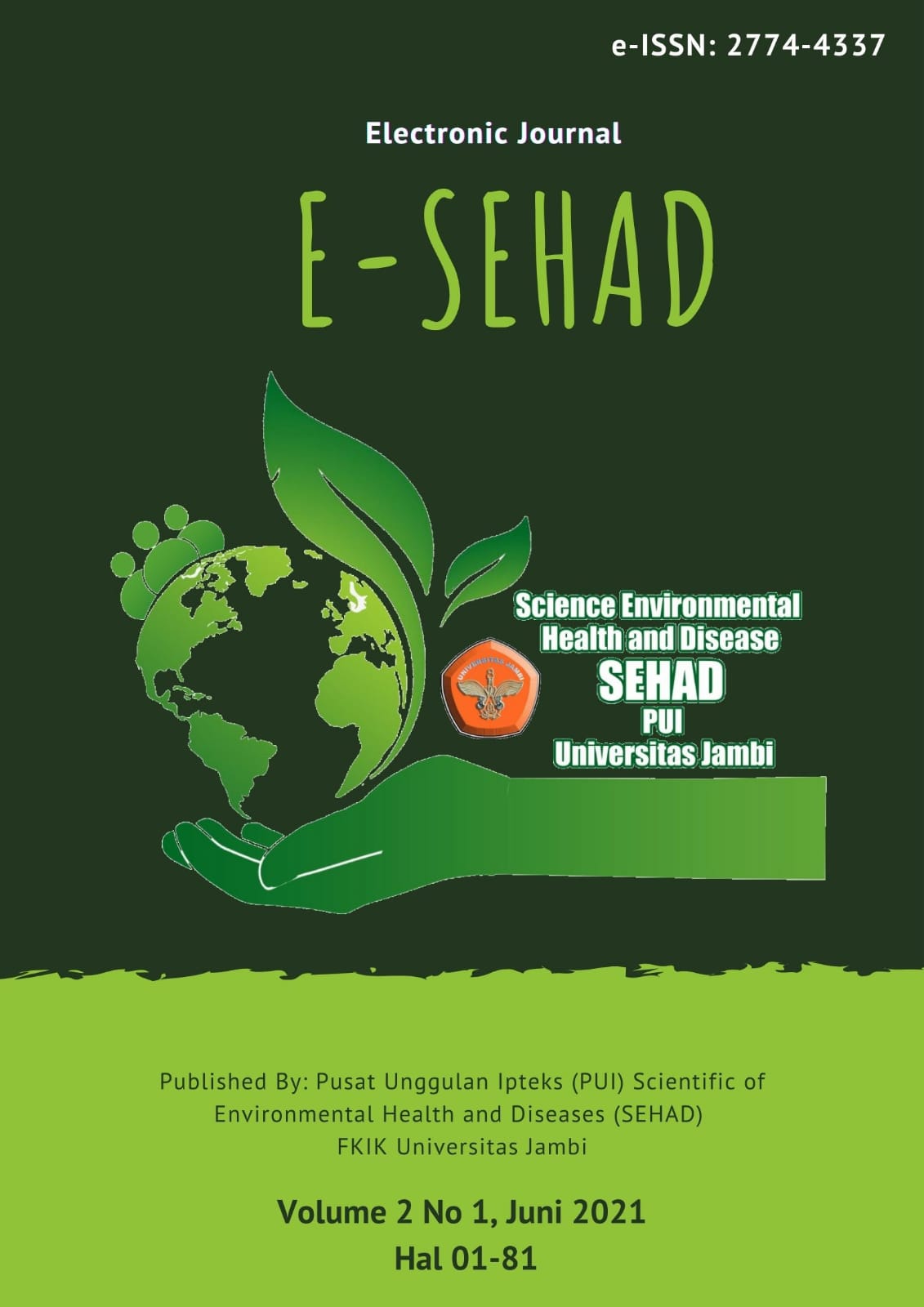GAMBARAN AMBANG NYERI TRIGGER POINT PADA PASIEN TENSION-TYPE HEADACHE DI KOTA JAMBI
DOI:
https://doi.org/10.22437/esehad.v2i1.16173Keywords:
Keywords: tension-type headache, myofascial trigger points, pain thresholdAbstract
ABSTRACT
Introduction: The pathogenesis of tension-type headache (TTH) is unclear; however, studies report a correlation between lowered pain thresholds at myofascial trigger points (MTrP) as a cause of cervical spasm, that can develop further into TTH. The MTrP pain threshold among TTH patients in the city of Jambi has never been described.
Method: Adult patients diagnosed with TTH in Jambi city are measured for their pain thresholds at the muscles of four known MTrPs: the trapezius, sternocleidomastoid, temporalis, and sub-occipital muscles. Results are then analyzed.
Results: Fifty-three subjects were obtained (53 female, 18 male) with the largest age group between 26-40 years old, and most frequent profession to be government worker and housewife. Based on the average pain thresholds of the four MTrPs, the lowest to highest average measurements are on the temporalis muscle (1.93 kg/cm2), m. sternocleidomastoid (2.48 kg/cm2), m. sub-occipital (2.50 kg/cm2) dan trapezius (2.63 kg/cm2).
Conclusion: MTrP pain threshold measurements can be considered as a routine examination among TTH patients, as MTrP plays a significant role in the pathogenesis of TTH and potentially as a target of multimodal therapy.
Keywords: tension-type headache, myofascial trigger points, pain threshold
ABSTRAK
Latar belakang: Patogenesis dari tension-type headache (TTH) belum diketahui secara jelas, namun laporan dari beberapa studi menunjukkan bahwa rendahnya ambang nyeri pada beberapa trigger point di otot-otot servikal memiliki korelasi dengan TTH. Nilai ambang nyeri pada trigger point di antara pasien-pasien (TTH) di kota Jambi belum pernah digambarkan.
Metode: Pasien-pasien dewasa dengan diagnosis (TTH) di rumah sakit di kota Jambi menjalani pengukuran ambang nyeri dengan algometer pada myofascial trigger point (MTrP) di beberapa titik, yaitu musculus trapezius, sternocleidomastoid, temporalis, dan sub-occipitalis bilateral. Hasil pengukuran kemudian dianalisis.
Hasil: Subyek yang didapat yaitu sebanyak 53 pasien (35 perempuan, 18 laki-laki), dengan golongan usai terbanyak yaitu 26-40 tahun. Pekerjaan yang terbanyak yaitu pegawai negeri sipil dan ibu rumah tangga. Dari keempat MTrP, rata-rata ambang nyeri yang terendah hingga tertinggi yaitu m. temporalis (1.93 kg/cm2), m. sternocleidomastoid (2.48 kg/cm2), m. sub-occipital (2.50 kg/cm2) dan m. trapezius (2.63 kg/cm2).
Kesimpulan: Pengukuran ambang nyeri pada MTrP dapat dipertimbangkan sebagai suatu pemeriksaan rutin pada pasien dengan TTH, agar dapat dipertimbangkan perannya dalam patogenesis TTH dan sebagai target dalam terapi multimodal.
Kata kunci: tension-type headache, myofascial trigger point, ambang nyeri
Downloads
References
Fishbain DA, Lewis J, Cole B, et al. Do the proposed cervicogenic headache diagnostic criteria demonstrate specificity in terms of separating cervicogenic headache from migraine? Curr Pain Headache Rep. 2003;7(5):387–94. https://doi.org/10.1007/s11916- 003-0039-8. Medline:12946293
Jull G, Sterling M. Whiplash, headache and neck pain: research- based directions for physical therapies. London: Churchill Livingstone; 2008.
Headache Classification Committee of the International Headache Society. The international classification of headache disorders, 3rd edition (beta version). Cephalalgia. 2013;33(9):629–808.
Biondi DM. Cervicogenic headache: a review of diagnostic and treatment strategies. J Am Osteopath Assoc. 2005;105(4 Suppl 2):16S–22S. Medline:15928349
Sjaastad O, Fredriksen TA, Pfaffenrath V; Cervicogenic Headache International Study Group. Cervicogenic headache: diagnostic criteria. Headache. 1998;38(6):442–5. https://doi.org/10.1046/j.1526- 4610.1998.3806442.x. Medline:9664748
Haldeman S, Dagenais S. Cervicogenic headaches: a critical review. Spine J. 2001;1(1):31–46. https://doi.org/10.1016/S1529- 9430(01)00024-9. Medline:14588366
Simons DG, Travell JG, Simons LS. Travell and Simons’ myofascial pain and dysfunction: The trigger point manual. Vol. 1, Upper half of body. Philadelphia: Williams & Wilkins; 1999.
Zhuang X, Tan S, Huang Q. Understanding of myofascial trigger points. Chin Med J (Engl). 2014;127(24):4271–7. Medline:25533832
Bron C, Dommerholt JD. Etiology of myofascial trigger points. Curr Pain Headache Rep. 2012;16(5):439–44. https://doi.org/10.1007/ s11916-012-0289-4. Medline:22836591
Simons DG. Understanding effective treatments of myofascial trigger points. J Bodyw Mov Ther. 2002;6(2):81–8. https://doi.org/10.1054/ jbmt.2002.0271.
Ferna Ìndez-de-Las-Pen ̃as C, Simons D, Cuadrado ML, et al. The role of myofascial trigger points in musculoskeletal pain syndromes of the head and neck. Curr Pain Headache Rep. 2007;11(5):365–72. https://doi.org/10.1007/s11916-007-0219-z. Medline:17894927
Kinser AM, Sands WA, Stone MH. Reliability and validity of a pressure algometer. J Strength Cond Res. 2009;23(1):312–4. https:// doi.org/10.1519/JSC.0b013e31818f051c. Medline:19130648
Ornetti P, Dougados M, Paternotte S, et al. Validation of a numerical rating scale to assess functional impairment in hip and knee osteoarthritis: comparison with the WOMAC function scale. Ann Rheum Dis. 2011;70(5):740–6. https://doi.org/10.1136/ ard.2010.135483. Medline:21149497
Potter L, McCarthy C, Oldham J. Algometer reliability in measuring pain pressure threshold over normal spinal muscles to allow quantification of anti-nociceptive treatment effects. Int J Osteopath Med. 2006;9(4):113–9. https://doi.org/10.1016/j.ijosm.2006.11.002.
Moraska AF, Schmiege SJ, Mann JD, et al. Responsiveness of myofascial trigger points to single and multiple trigger point release massages: a randomized, placebo controlled trial. Am J Phys Med Rehabil. 2017;96(9):639–45. https://doi.org/10.1097/PHM.0000000000000728. Medline:28248690
Cohen J. A power primer. Psychol Bull. 1992;112(1):155–9. https://doi.org/10.1037/0033-2909.112.1.155. Medline:19565683
Couppe Ì C, Torelli P, Fuglsang-Frederiksen A, et al. Myofascial trigger points are very prevalent in patients with chronic tension-type headache: a double-blinded controlled study. Clin J Pain. 2007;23(1):23–7. https://doi.org/10.1097/ 01.ajp.0000210946.34676.7d. Medline:17277641
Page P. Cervicogenic headaches: an evidence-led approach to clinical management. Int J Sports Phys Ther. 2011;6(3):254–66. Medline:22034615
Jull G, Barrett C, Magee R, et al. Further clinical clarification of the muscle dysfunction in cervical headache. Cephalalgia. 1999;19(3):179–85. https://doi.org/10.1046/j.1468- 2982.1999.1903179.x. Medline:10234466
Hall T, Briffa K, Hopper D. Clinical evaluation of cervicogenic headache: a clinical perspective. J Manual Manip Ther. 2008;16(2):73–80. https://doi.org/10.1179/106698108790818422. Medline:19119390
Ziaeifar M, Arab AM, Nourbakhsh MR. Clinical effectiveness of dry needling immediately after application on myofascial trigger point in upper trapezius muscle. J Chiropr Med. 2016;15(4):252–8. https:// doi.org/10.1016/j.jcm.2016.08.009. Medline:2785763


